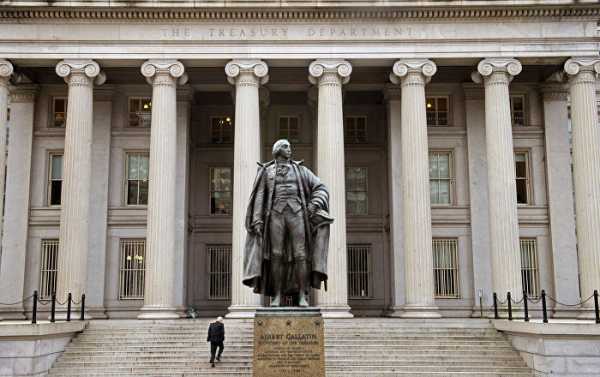
Holders of US governmental bonds are rushing to reallocate capital in order to take advantage of more profitable opportunities, which are increasingly opening up amidst the ongoing expansion cycle in the broader economy.
Kristian Rouz — Debt market speculators are selling 5-year and 10-year Treasury notes at record-high volumes, as the acceleration in the US economy suggests there are more lucrative investment options in the stock market and the non-financial sector.
Simultaneously, investors have ramped up their net long positions on the US dollar to their highest level since 2017.
According to a report from the Commodity Futures Trading Commission (CFTC), the total volume of short, or bearish, speculative positions on 10-year Treasury futures exceeded long, or bullish, positions, by 509,498 contracts.
Meanwhile, speculators held 715,965 bearish contracts on 5-year US government bonds.
This suggests the US Treasury market is bracing for a major sell-off, likely suppressing the bond value and pushing yields up — which would also add to the upward pressure on the natural interest rate and support the Federal Reserve’s policies of gradual rate increases.
A sell-off in government bonds typically either reflects a solid pace of economic expansion with lucrative opportunities opening up outside of the low-yielding bond market, or it points to fears of a government financial collapse, as in times of war. As applied to the current financial conditions in the US, the former scenario should be deemed more likely.
However, some experts are not convinced that the solid pace of economic expansion is behind the looming bond sell-off.
“We’re all in this bond bed together and the driver of yields may have a lot less to do with growth and inflation expectations and more to do with their (central banks’) change of policy.” Peter Boockvar of the Bleakley Advisory Group said. “After all, less dominance over the markets is going to have an opposite impact, to some extent.”
This comes as the US GDP growth rate accelerated to its almost four-year highest in the second quarter of this year. The pace of economic expansion in 2Q18 sped up to 4.1 percent year-on-year, compared to a 2.2-percent growth in the previous quarter, and 3.1 percent back in 2Q17.
The Commerce Department’s data showed that the ongoing economic boom in the US is driven by elevated levels of consumer spending, an increased business investment — particularly, in the non-financial Main Street economy —as well as increasing exports.
“We’re on track to hit the highest annual growth rate in over 13 years,” US President Donald Trump said.
And bond investors appear to agree with the President’s assessment.
The White House has been touting a possible second round of tax cuts, which would provide an additional fiscal stimulus to the economy. Additionally, ongoing cuts to red tape have been quite supportive of business sentiment, while the prospect of new bilateral trade deals has lifted exporter confidence.
A separate report from the CFTC shows currency speculators have increased their net long, or bullish, positions on the US dollar to $20.33 bln, up from $18.41 bln earlier this month. This points to a likely increased demand for dollar-denominated liquidity and could push the dollar’s FX rate higher — which in turn could hamper US exports.
Investor confidence in the US dollar has been rising over the past few months amid a solid macroeconomic backdrop in the US, as well as currency crises in the emerging markets.
Some experts say tighter monetary policies in the US, compared to the still-accommodative conditions in the Eurozone and Japan, have also contributed to the dollar’s rising appeal.
“Interest rate differentials continue to support the US dollar.” Greg Michalowski of Scottsdale, Ariz.-based ForexLive.com said. “We saw GDP in the US reach 4.1 percent, which is higher than any of the other major currencies. Those economic fundamentals keep the dollar at a premium to its rivals.”
The ongoing macroeconomic realignment in the US is expected to lift longer-term GDP growth projections. This, in turn, would support the reallocation of capital from financial and safe-have assets — such as Treasury bonds and real estate — into more volatile, yet more profitable (during an economic boom), endeavors.
Federal Reserve officials expect US economic growth to average at 2.8 percent this year, and then slow down to 2.4 percent in 2019, and 2 percent in 2020. However, Fed calculations don’t account for the accommodative effects of the expected second round of tax cuts, as well as the multiplier effect of supply-side policies.
As suggested by the CFTC data, changes in domestic investment patterns might point to a longer-term expansion cycle this time around.
Sourse: sputniknews.com






